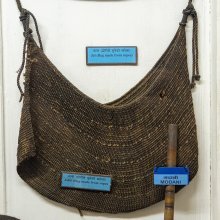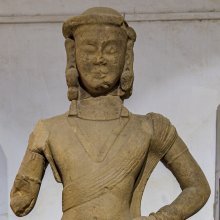Rope: 3 definitions
Introduction:
Rope means something in Hinduism, Sanskrit, the history of ancient India. If you want to know the exact meaning, history, etymology or English translation of this term then check out the descriptions on this page. Add your comment or reference to a book if you want to contribute to this summary article.
Images (photo gallery)
In Hinduism
Natyashastra (theatrics and dramaturgy)
Source: Shodhganga: Elements of Art and Architecture in the Trtiyakhanda of the Visnudharmottarapurana (natya)The Rope is associated with Kapittha-hasta: one of the twenty-two Single-hand Gestures (in Indian Dramas) (known as asaṃyuktahastas), according to the Viṣṇudharmottarapurāṇa, an ancient Sanskrit text which (being encyclopedic in nature) deals with a variety of cultural topics such as arts, architecture, music, grammar and astronomy.—In the Śabdakalpadruma, the word kapittha is explained as a kind of tree where kapi i.e., monkey comes due to the greed of fruit. The word kapittha again denotes the fruit called wood apple. [...] This posture is used to denote sacrifice, holding of an umbrella or a garland or rope, dragging and fanning.

Natyashastra (नाट्यशास्त्र, nāṭyaśāstra) refers to both the ancient Indian tradition (shastra) of performing arts, (natya—theatrics, drama, dance, music), as well as the name of a Sanskrit work dealing with these subjects. It also teaches the rules for composing Dramatic plays (nataka), construction and performance of Theater, and Poetic works (kavya).
Ayurveda (science of life)
Agriculture (Krishi) and Vrikshayurveda (study of Plant life)
Source: Shodhganga: Drumavichitrikarnam—Plant mutagenesis in ancient IndiaRopes (made of straw) (in Sanskrit: Palāla-Rajju) were used for tying together the stems of plants, as prescribed by certain bio-organical recipes for plant mutagenesis, according to the Vṛkṣāyurveda by Sūrapāla (1000 CE): an encyclopedic work dealing with the study of trees and the principles of ancient Indian agriculture.—Accordingly, “If thick stems of Cucumis melo var. utilissiumus and Benincasa hispida plants are smeared with honey and melted butter then tied together with straw rope (palāla-rajju) and then covered with cow dung they become one. Later, if the stem is cut keeping the order of the root and tip, Cucumis melo var. utilissiumus, bears fruits of Benincasa hispida size”.

Āyurveda (आयुर्वेद, ayurveda) is a branch of Indian science dealing with medicine, herbalism, taxology, anatomy, surgery, alchemy and related topics. Traditional practice of Āyurveda in ancient India dates back to at least the first millenium BC. Literature is commonly written in Sanskrit using various poetic metres.
India history and geography
Source: Singhi Jain Series: Ratnaprabha-suri’s Kuvalayamala-katha (history)1) Ropes (of boats and ships) were pulled up, as part of preparatory rituals performed before Sea-voyages in ancient India (known in Prakrit as: jattā, or Sanskrit: yātrā), and was vividly depicted in the Kathās (narrative poems) such as Uddyotanasūri in his 8th-century Kuvalayamālā (a Prakrit Campū, similar to Kāvya poetry).—[...] When the ship was to take off auspicious musical instruments were sounded, conch-shells were blown, auspicious songs were sung, Brahmins muttered the āsīsā; and thus in the sound of invocation and jaya jaya the ship took off its voyage, the sails were unfurled, the ropes and riggings were pulled up, the oars began to be operated, the helmsman took observations, the ship fell into its course, favourable winds began to blow: thus the ship started its journey being tossed on the high sea waves.
2) Ropes (tied round their necks of bullocks) represents a scene of human life commonly depicted on the Saṃsāracakra paintings in ancient India, according to the Kuvalayamālā.—Page 185.21 f.: Here follows a description of a printed scroll illustrating the Jaina conception of saṃsāracakra. [...] The saṃsāra-cakra illustrated the three worlds of hell, human world and the world of gods. [For example:] the agriculturists engaged in ploughing their field with plough, bullocks with pierced nostrils and with ropes tied round their necks, having ploughs on their necks, and bleeding owing to their having been pricked with sharp pointed whips.

The history of India traces the identification of countries, villages, towns and other regions of India, as well as mythology, zoology, royal dynasties, rulers, tribes, local festivities and traditions and regional languages. Ancient India enjoyed religious freedom and encourages the path of Dharma, a concept common to Buddhism, Hinduism, and Jainism.
See also (Relevant definitions)
Starts with: Ropenta, Ropesi, Ropeti, Ropetva.
Ends with (+2): Aarope, Beach heliotrope, Bur-beggar tick of europe, Bush rope, Cleftleaf wild heliotrope, Common poison rope, Faffa rope, Forest poison rope, Heliotrope, History of Europe, Indian heliotrope, Kupa-rope, Monkey rope, Red rope, Salt heliotrope, Seaside heliotrope, Silvery oxytrope, Smooth heliotrope, Snake rope, Spatulate-leaved heliotrope.
Full-text (+1139): Rajju, Vatsatantri, Solakhanda, Daman, Labhasa, Padarajju, Chidira, Natha, Damodara, Pasha, Rajjubandha, Guna, Vatsatanti, Varataka, Vanthara, Rajjumaya, Vethana, Alana, Bandhanagranthi, Shikya.
Relevant text
Search found 252 books and stories containing Rope; (plurals include: Ropes). You can also click to the full overview containing English textual excerpts. Below are direct links for the most relevant articles:
Garga Samhita (English) (by Danavir Goswami)
Verse 1.19.8 < [Chapter 19 - Breaking of the Two Arjuna Trees]
Verse 5.9.2 < [Chapter 9 - The Happiness of the Yadus]
Verse 2.7.11 < [Chapter 7 - Kidnapping of the Calves and Cowherd Boys]
Rig Veda (translation and commentary) (by H. H. Wilson)
Folklore of the Santal Parganas
Chapter CVI - The Speaking Crab < [Part I]
Chapter LXXVII - The Wife Who Could Not Keep a Secret < [Part I]
Chapter II - Anuwa and His Mother < [Part I]
Matangalila and Hastyayurveda (study) (by Chandrima Das)
Āpātabandha: The fourth technique < [Chapter 3]
Vāribandha: The first technique < [Chapter 3]
Anugatabandha: The third technique < [Chapter 3]
Bhajana-Rahasya (by Srila Bhaktivinoda Thakura Mahasaya)
Text 6 < [Chapter 7 - Saptama-yāma-sādhana (Pradoṣa-kālīya-bhajana–vipralambha-prema)]
Text 30 < [Chapter 2 - Dvitīya-yāma-sādhana (Prātaḥ-kālīya-bhajana)]
Text 5 < [Chapter 2 - Dvitīya-yāma-sādhana (Prātaḥ-kālīya-bhajana)]
Manusmriti with the Commentary of Medhatithi (by Ganganatha Jha)
Verse 8.369 < [Section XLVI - Adultery]
Verse 4.210 < [Section XIV - Other Duties]
Verse 5.118 < [Section XIII - Purification of Substances]
Related products


